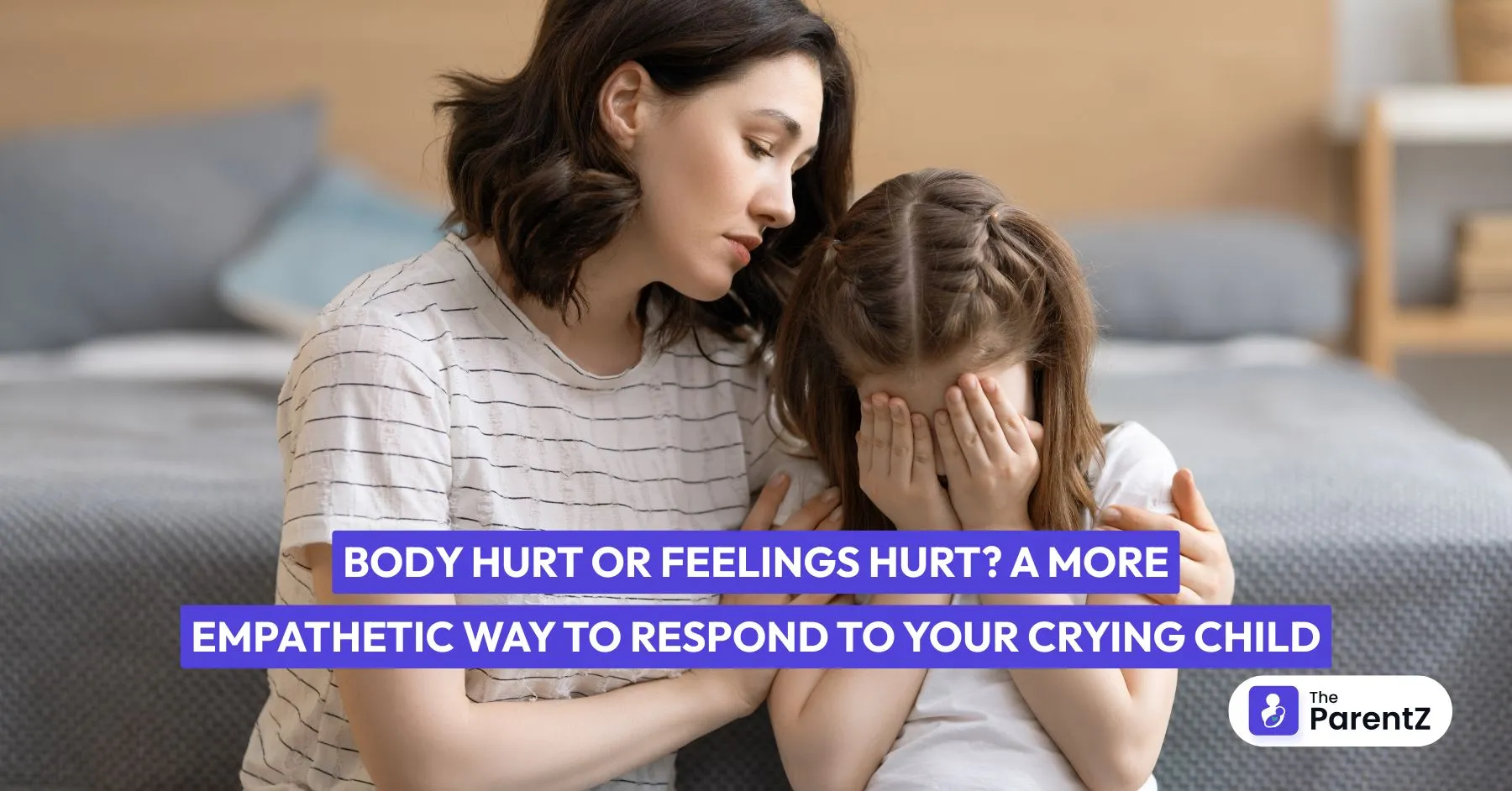Picture this: Your four-year-old comes running into the kitchen with tears streaming down their face. Your heart rate instantly spikes. What happened? Is it serious? Before you even have time to assess the situation, those automatic words tumble out: "You're okay!"
Sound familiar?
As parents, our instinct to comfort and reassure is lightning-quick. We want to make everything better—fast. But in our rush to calm the storm, we might accidentally miss a golden opportunity to truly connect with our children when they need us most.
That's where a simple question is changing the game for families everywhere: "Is your body hurting, or is it your feelings?"
This small shift in how we respond to tears isn't just changing conversations—it's transforming relationships between parents and children, one emotional moment at a time.
The Problem with "You're Okay"
When a child is crying, saying "You're okay" might seem like the natural thing to do. After all, we want to reassure them that everything will be fine. We want to calm the situation. We want the crying to stop.
But think about it from your child's perspective for a moment. They're upset enough to cry. Something doesn't feel right to them. And here comes an adult telling them they're okay—when clearly, they don't feel okay at all.
What this unintentionally communicates is: "Your feelings aren't valid" or "Your experience doesn't matter as much as my need for you to stop crying." It can leave children confused about their own emotional experiences and less likely to trust their feelings.
Enter the Game-Changer Question
"Is your body hurting, or is it your feelings?"
This simple question accomplishes several powerful things at once:
- It validates that something is wrong: You're acknowledging that your child is experiencing discomfort of some kind rather than dismissing it.
- It offers a framework for understanding pain: Children often don't have the vocabulary or awareness to distinguish between physical and emotional pain.
- It calms panic—yours and theirs: When a child cries, parents often jump to worst-case scenarios. This question helps everyone pause and assess.
- It teaches emotional intelligence: Over time, children learn to identify and articulate their feelings more precisely.
How It Works in Real Life
Scenario 1: The Physical Owie
Your 3-year-old trips and falls on the sidewalk. Tears immediately follow.
Instead of: "You're okay! Up you go!"
Try: "Oh, that was a fall. Is your body hurting, or is it your feelings?"
If they say their body hurts, you can ask where specifically and address the physical pain. Maybe they need a band-aid, an ice pack, or just a gentle cleaning of a scrape.
The beauty of this approach is that it often prevents the escalation that happens when children feel unheard. Many times, acknowledging the pain is half the healing.
Scenario 2: The Emotional Wound
Your 5-year-old comes home from kindergarten in tears because a friend didn't want to play with them.
Instead of: "You're okay, you'll find someone else to play with tomorrow!"
Try: "You seem upset. Is your body hurting, or is it your feelings?"
When they tell you their feelings are hurt, you've opened the door to a conversation about emotions. "What feelings are you having right now? Sad? Disappointed? Lonely?" This helps them build an emotional vocabulary and understand that all feelings are valid and temporary.
Scenario 3: The Confusing Mix
Your 4-year-old has a full meltdown at bedtime. They're crying, and you're not sure why.
Instead of: "You're okay, it's just time for bed."
Try: "I see you're crying. Is your body hurting, or is it your feelings?"
Sometimes, they might say "both," which is perfectly valid! Children (and adults) often experience physical manifestations of emotional distress—tummy aches from anxiety, headaches from stress, or just the physical fatigue that makes emotions harder to manage.
Beyond the Either/Or
As children grow, this question can evolve. You might find yourself asking more specific questions:
- "What part of your body is hurting?"
- "What feelings are you having right now?"
- "Do you need help with your body, your feelings, or both?"
This approach gives children permission to have complex experiences and helps them develop the language to express those experiences.
Getting Started
Like any parenting tool, this approach takes practice for both you and your child. Here are some tips for getting started:
- Introduce the concept during calm times: You might say, "Sometimes when people cry, it's because their body hurts, like when you fall down. And sometimes people cry because their feelings are hurt, like when they feel sad or mad. Both kinds of hurt are important."
- Be patient with the learning curve: Very young children might not understand the difference right away, and that's okay.
- Use it consistently. The more you use this language, the more natural it will become for everyone.
- Apply it to yourself, too: When you're having a tough moment, you might say, "Mommy's feelings are hurt right now because I'm feeling frustrated. I need a few deep breaths to feel better."
Conclusion
This approach isn't about finding the perfect thing to say—it's about creating space for your child's full experience. Some days, you'll handle things beautifully. On other days, you'll fall back on "You're okay" out of habit or exhaustion. That's perfectly normal.
Parenting isn't about perfection; it's about connection. And asking "Is your body hurting, or is it your feelings?" is one small way to strengthen that connection, one crying episode at a time.
The next time your little one bursts into tears, try pausing before automatically saying, "You're okay." Take a breath and ask that simple question instead. You might be surprised at what you learn about your child—and yourself—in the process.








Be the first one to comment on this story.